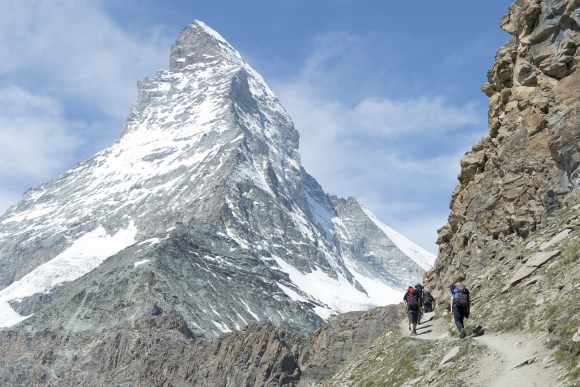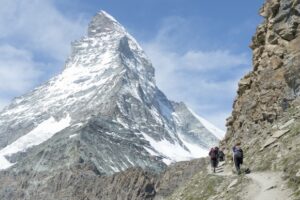
 The Matterhorn, one of the most iconic peaks in the Alps, is a formidable challenge for climbers from around the world.
The Matterhorn, one of the most iconic peaks in the Alps, is a formidable challenge for climbers from around the world.
Its distinctive pyramidal shape towers over the surrounding landscape, drawing adventurers and mountaineers to its slopes.
However, this majestic mountain is not just a symbol of beauty; it also represents the inherent dangers of high-altitude climbing.
Recently, another climber has lost their life on this treacherous mountain, underscoring the risks associated with alpine pursuits.
The Matterhorn stands at 4,478 meters (14,692 feet) and straddles the border between Switzerland and Italy. It has long captivated climbers, first summited in 1865 by a team led by Edward Whymper. Since then, it has become a coveted goal for mountaineers of various skill levels, from seasoned experts to novices seeking adventure. Yet, its allure is paired with significant risks, including unpredictable weather, rockfall, and challenging technical routes.
The recent tragedy highlights a grim reality: the Matterhorn is one of the deadliest peaks in the Alps. Climbing accidents occur frequently, often due to a combination of factors such as human error, sudden weather changes, and the physical demands of the ascent.
The mountain’s popularity means that thousands attempt to reach its summit each year, increasing the likelihood of accidents.
In this particular incident, details remain sparse, but reports indicate that the climber was part of a larger group. As they ascended, they likely encountered the mountain’s notorious conditions, which can shift rapidly.
High winds, sudden storms, and temperature drops are common at altitudes where even experienced climbers can find themselves in peril. Despite the best preparations, the mountain can be unforgiving.
Emergency services responded quickly, but the harsh environment poses challenges in rescue operations. The steep, rocky terrain and unpredictable weather conditions can complicate efforts to retrieve climbers in distress. In many cases, climbers must rely on their skills, teamwork, and experience to navigate safely and make sound decisions about when to turn back. Sadly, some do not make it in time, and lives are lost in pursuit of adventure.
The loss of life on the Matterhorn brings to light the broader discussion of climbing ethics and safety. As climbing has become more popular, there has been an increasing emphasis on training, preparation, and respect for the mountain.
Many organizations offer courses aimed at educating climbers about the risks involved and the necessary skills to mitigate those risks. Yet, no amount of training can fully prepare someone for the unpredictable nature of high-altitude climbing.
There is also the psychological aspect of climbing that plays a role in these tragedies.
The desire to reach the summit can sometimes cloud judgment, leading climbers to push beyond their limits. The phenomenon known as summit fever can cause individuals to disregard warnings and take unnecessary risks. Experienced climbers often emphasize the importance of knowing when to turn back, regardless of how close they may be to the summit.
The Matterhorn, with its breathtaking views and challenging routes, serves as a stark reminder of the fine line between adventure and danger.
The recent death of another climber is a tragic addition to the mountain’s history, prompting discussions among the climbing community about safety practices, awareness, and the importance of respecting nature’s power.
In the wake of such tragedies, it is crucial for climbers to engage in honest self-assessment and thorough preparation.
Understanding personal limits, obtaining proper training, and being aware of weather conditions are fundamental to increasing safety on the mountain. Moreover, climbers should also consider the importance of experience in their climbing partners.
Team dynamics can play a significant role in ensuring safety, as experienced climbers can provide guidance and support to less experienced members.
Rescue operations on the Matterhorn and other alpine areas continue to evolve, with advancements in technology aiding efforts. Drones, for instance, can be deployed to assess situations from the air, providing critical information for rescuers. However, the best approach remains proactive: climbers must prioritize safety, plan meticulously, and respect the mountain’s unpredictability.
As the climbing community reflects on this recent loss, the tragedy serves as a poignant reminder of the beauty and danger that coexist in the alpine environment. Each climber who sets foot on the Matterhorn carries with them not only the thrill of adventure but also the weight of responsibility—to themselves, their partners, and the mountain itself.
Ultimately, while the allure of the Matterhorn will continue to draw climbers, it is imperative to honor the mountain’s legacy by fostering a culture of safety and respect. Every ascent should be approached with caution and humility, recognizing that nature can be both a playground and a perilous realm. The climbing community must come together to share knowledge, promote safe practices, and remember those who have lost their lives in pursuit of their dreams.
In conclusion, the death of another climber on the Matterhorn serves as a tragic reminder of the risks inherent in high-altitude climbing. As climbers continue to pursue the summit, they must prioritize safety, respect the mountain, and learn from past tragedies to ensure that their adventures are both fulfilling and safe. The Matterhorn will remain a testament to human ambition and the enduring spirit of adventure, but it must also be approached with the reverence it commands.
Leave a Reply